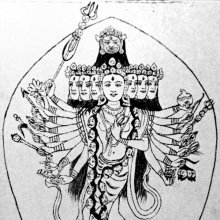Amritamukhi, Amṛtamukhī: 1 definition
Introduction:
Amritamukhi means something in Buddhism, Pali. If you want to know the exact meaning, history, etymology or English translation of this term then check out the descriptions on this page. Add your comment or reference to a book if you want to contribute to this summary article.
The Sanskrit term Amṛtamukhī can be transliterated into English as Amrtamukhi or Amritamukhi, using the IAST transliteration scheme (?).
Images (photo gallery)
In Buddhism
Tibetan Buddhism (Vajrayana or tantric Buddhism)
Source: archive.org: The Indian Buddhist IconographyAmṛtamukhī (अमृतमुखी) is an epithet of Prasannatārā: one of the various emanations of Ratnasambhava, as mentioned in the 5th-century Sādhanamālā (a collection of sādhana texts that contain detailed instructions for rituals).—The sādhana devoted to her independent form gives her the epithets of Amṛtamukhī and Amṛtalocanā and there is no doubt that except for the face on the top all her seven faces are represented as having charmingly sweet expression. But she is not benign and peaceful. She is fearful like Vidyujjvālākarālī, a form of Ekajaṭā.

Tibetan Buddhism includes schools such as Nyingma, Kadampa, Kagyu and Gelug. Their primary canon of literature is divided in two broad categories: The Kangyur, which consists of Buddha’s words, and the Tengyur, which includes commentaries from various sources. Esotericism and tantra techniques (vajrayāna) are collected indepently.
See also (Relevant definitions)
Full-text: Amritalocana, Prasannatara.
Relevant text
Search found 1 books and stories containing Amritamukhi, Amṛtamukhī, Amrtamukhi; (plurals include: Amritamukhis, Amṛtamukhīs, Amrtamukhis). You can also click to the full overview containing English textual excerpts. Below are direct links for the most relevant articles:
The Indian Buddhist Iconography (by Benoytosh Bhattachacharyya)
